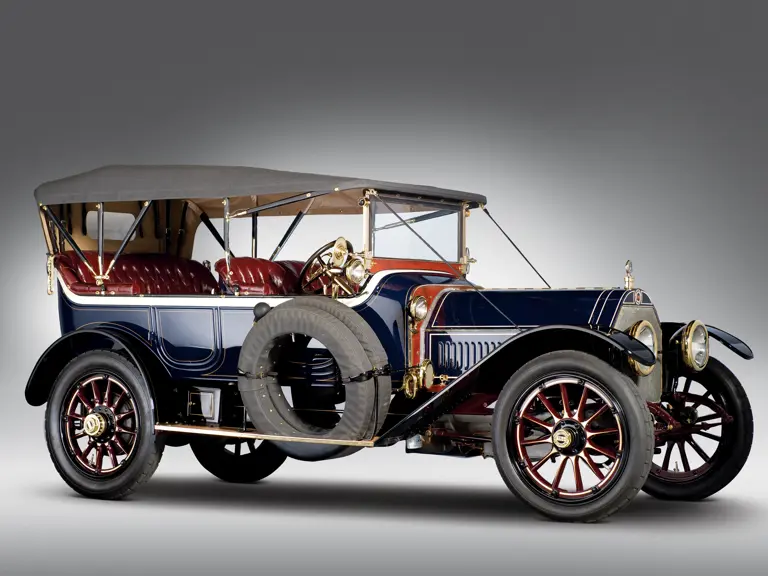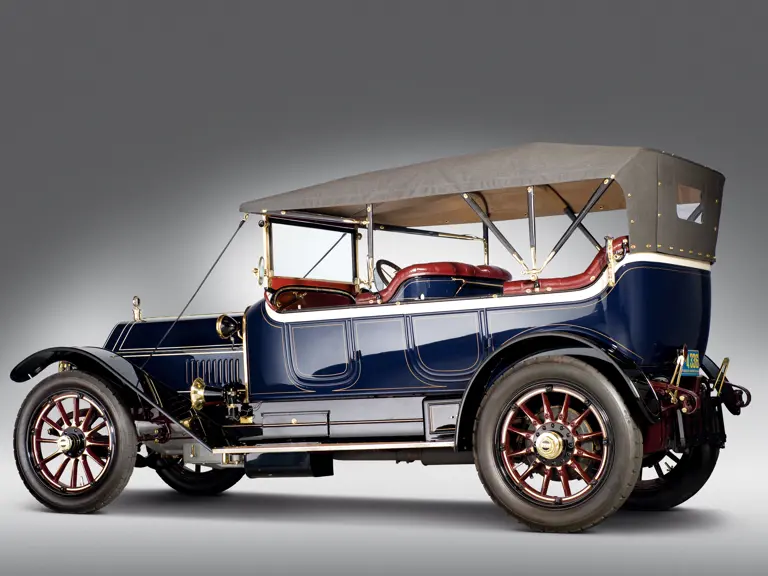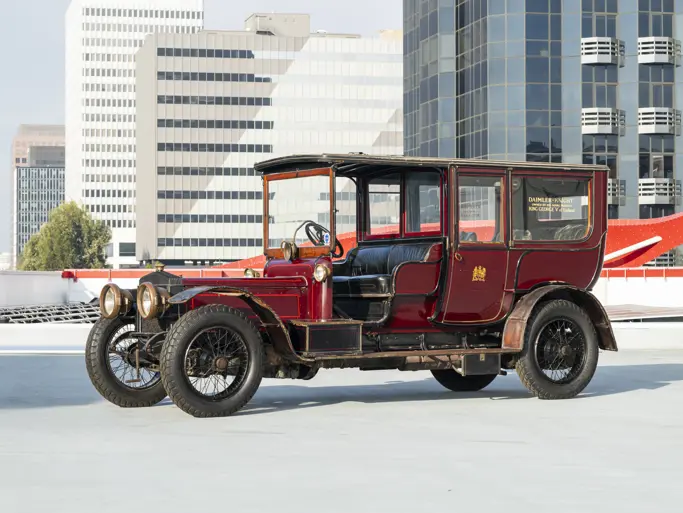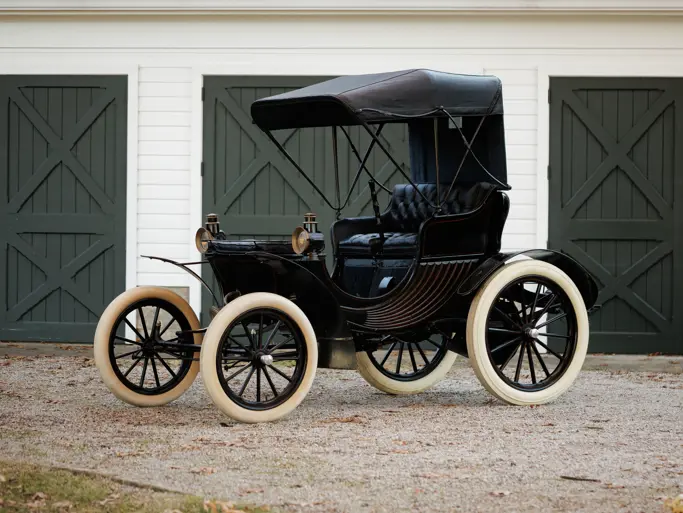Model H. 60 hp, 524.8 cu. in. inline T-head six cylinder engine, four-speed manual transmission, solid front axle and live rear axle with semi-elliptic leaf springs, and two-wheel mechanical brakes. Wheelbase: 133.5"
• High-horsepower Brass Era touring car
• Last year of the storied Alco marque
• One of the most expensive American cars of the era
• One of only six examples known to exist
• AACA Senior and Swigart honors as well as Pebble Beach award
The American Locomotive Company began building American Berliet cars in Providence, Rhode Island in 1906, having secured the US license to build the highly-respected Berliet automobiles of Lyon, France for a period of three years. Marius Berliet was a trained mechanic and engineer, and he produced his first automobile in France around 1894.
The first American Berliets were shown at the November 1906 New York Auto Show held at the Grand Central Palace. These were four-cylinder chain drive cars. In 1908, the four-cylinder models were changed from chain to shaft drive. In 1910, a shaft drive six-cylinder model was introduced. By September of that year, American Berliet engineers, believing they had gleaned enough knowledge to build cars on their own, persuaded American Locomotive management to begin building entire cars in-house without the use of Berliet designs. This continued until the auto plant was closed for good. However, a Berliet influence remained with the mighty Alcos as long as they were produced; the engine and many other parts were still built in metric measure!
Alco automobiles rightly belong in the same pantheon of great early US cars as Pierce-Arrow, Packard, Locomobile, Chadwick, Peerless, Lozier, Stearns, Simplex and Thomas. The Alco’s specifications and construction are legendary. For instance, a veteran Alco machinist once related how the quality control on crankshaft grinds was enforced. Once the billet had been machined it had to be perfect on every journal after the initial grind or it would be dumped in the Providence River and a new billet ground, this time perhaps to perfection! No wonder Alco claimed it took one year and seven months to build each car.
The new 1909 Alco was sent out to prove its soundness by entering—and winning—the grueling Vanderbilt Cup Race in that year, beating Fiat, Mercedes, National, Marmon, Isotta, Buick and Simplex. In 1910, Alco repeated the feat, beating Marmon, National, Lozier, Pope, Simplex, Benz and Mercedes! Alco also paid close attention to body styling, and by 1912 the distinctive white stripe running around the top of the elegant Alco coachwork instantly identified the renowned road locomotives from Providence. Alcos also became the most expensive cars in America during this time, reflecting the quality of materials, design and workmanship lavished upon them. Despite the high prices, however, a careful cost analysis revealed that American Locomotive was losing an average of $460 on each car built and had been doing so since the venture began in 1906! This became Alco’s death knell, and the marque was discontinued in late 1913, bringing to a close the saga of a car that was perhaps built too well to survive in the marketplace of its time.
The car on offer here is almost certainly the 1913 New York Show car based on its one-off steering tube angle, slightly longer cowl, deeper front seat placement and five-passenger Fleetwood body configuration. It was originally sold in Cleveland on August 10, 1913, and we understand it remained there in various owners’ and collectors’ hands until the late 1960s. The previous owner acquired the car in 1989 and commenced restoration. This work was completed in the shops of well-known brass car restorer Stu Laidlaw, who carried out metalworking, painting, engine and drivetrain renovation, brass and trim work and final assembly. Top and interior work was accomplished by master upholsterer Leif Drexler using Fleetwood builder’s photographs and leather samples from an original 1913 Alco in order to ensure total authenticity.
Upon completion of its full restoration in 1995, the car was taken to Pebble Beach and won second in its class. It also won a First National Junior AACA award and then a Senior National First place at Hershey in the same year. It then went on the win the AACA’s 1996 Swigart Award for the best restoration of a rare car in the previous year.
After its appearances and wins on the show circuit, the engine and drivetrain were re-restored for serious brass car touring events. This included fitting a modern clutch, hidden hydraulic disc brakes within the rear drums, a Pierce-Delco dual distributor with electronic ignition hidden within and very strong LED brake lights. All of these updates were accomplished without modifying any original components, and the car may be returned to original specifications should the new owner wish. New connecting rods were made during the first restoration. Tom Lester re-babbitted all bearings and had new pistons made during the second rebuild. During its restoration from 1990 to 1995, a new crankcase was patterned, cast and machined. The engine was rebuilt during 1998 to 1999 using hardened valve seats, a Moldex counterbalanced crankshaft, newly babbitted connecting rods and aluminum pistons. Hidden 160-degree thermostats in each set of cylinders assure proper operating temperatures at all speeds and elevations. A new crankcase was cast and vacuum impregnated with clear high temperature epoxy to prevent leaks and seepage.
The result of all this work is a car that is not only visually imposing, with exceptional beauty of line and superb workmanship, but is also an early motor car that has proven itself on the Transcontinental Tour for pre-1915 cars, the famous Red Rock Rendezvous tours, Circle South, 2000 HCCA Millennium Tour and a New England Brass & Gas. This rugged, majestic and handsome Alco, one of only six of the massive six-cylinder cars known to exist, would be welcome at a wide variety of tours, shows and concours. There is no question that the Alco will acquit itself with outstanding performance and will draw the admiration of seasoned connoisseurs and casual observers alike. The Alco is a rarely seen car that is at once imposing and powerful yet understated with sophisticated design.




 | Boca Raton, Florida
| Boca Raton, Florida


